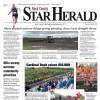By Lori EhdeThe Hinkly House kitchen, furnished with original turn-of-the century appliances, takes visitors back to a time before electricity, let alone Pillsbury cake mixes and Hamburger Helper.The public will have an opportunity to absorb local history by means of live, costumed tours from 2 to 4 p.m. Sunday, July 18, in all rooms of the Hinkly House museum.In the Hinkly kitchen, for example, Sister Mariella Hinkly, granddaughter of R.B. Hinkly who built the house in 1892, tells how the cookstove was used.It was fueled primarily by corncobs, which also served as a heat source for the room, vented through the stove pipe to the outside.She said some women calculated baking times and temperatures based on how many corncobs to use. For example, a perfect loaf of bread requires exactly 11 cobs if they were allowed to burn out."These ladies were pros," Hinkly said. "They made angel food cakes on these cookstoves."Also featured on the Hinkly stove are cast iron cookware, a toaster (the slices were propped on the sides of the pyramid-shaped utensil) and a prized copper kettle.The 135-year copper coffee pot was handmade in Norway and given to the Hinkly House by the wife of Knute Stein, the Norwegian stonecutter who carved the lions in the front of the house.The kitchen lends plenty of other evidence of practical turn-of-the century life.A dumb waiter serves all floors from basement to attic, and a pie-saver cabinet shows how pies were preserved in vented, custom-made slots.A spice rack, with compartments instead of bottles and jars, serves as a reminder of a day when women cooked in terms of "pinches" of pepper, ginger, cloves, etc.The kitchen features an ice box, and Hinkly said homemakers used to place cards in their windows so the ice man would know how many pounds of ice to bring in.When he chipped away at the blocks, she said children used to pick up chips that fell to the ground and lick them for thirst and heat relief on hot summer days.Hand-carved butter molds allowed families to press personal designs into butter pats, and the telephone on the wall of the Hinkly kitchen is known to be the first hooked up in Luverne.Hinkly said electricity hadn’t made it to Luverne when her grandfather built the house, but he had it wired for electricity so he’d be ready.Two years later, Luverne connected to power and the Hinkly house lit up. "Thank goodness he had the foresight to do that," Hinkly said.These are just a few details from one room in the Hinkly House. The Victorian Period home is filled with priceless historic artifacts, most of them belonging to the Hinkly family. Details in the master bedroom, for example, include a marble-top dresser containing R.B. Hinkly’s autograph book from his teenage years, hat pins long enough to secure hats and hairdos on windy days and a beaded purse.Located on North Freeman Avenue, the house served as the residence of pioneer Luverne businessman and early day mayor R.B. Hinkly.It was built in 1892 of Sioux quartzite from the Blue Mounds quarry hauled in on horse-drawn stone boats.The public is encouraged to learn more during Sunday’s tour.Local County K-Nine 4-H Club members will dress in period attire and recite details about rooms and furnishings as part of their Community Pride project.The Hinkly House and Rock County Museum summer hours are from 2 to 4 p.m. Tuesday, Thursday and Saturday afternoons, or by appointment. Or, call Sister Mariella Hinkly, 283-9849, to book a group tour.


